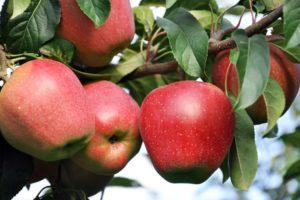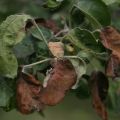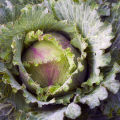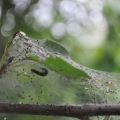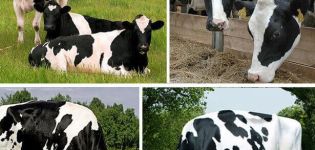How to process an apple tree if the leaves turn red and curl on it, what to do
The most common plant in summer cottages is the apple tree. Everyone expects a bountiful harvest from her. But it happens that red leaves begin to appear on the tree, which curl. This is a legitimate concern for gardeners. Affected foliage affects the growth of the plant and prevents it from developing correctly. At the first sign, you need to understand the reasons. Then understand how to process the leaves on the apple tree when they turn red and curl.
Disease symptoms and visual signs
If the leaves are curled, then you should pay close attention to the tree. By this it informs that the work of the organs has been disrupted. The lesions are examined to determine the cause. If at the same time the leaves dry and turn red, this is a sure sign that:
- pests appeared on the plant;
- the culture got sick.
Improper care may also be the cause.
Common causes of the disease
At the first sign, you should figure out why the leaves are curling. A common cause of deformation is recurrent frost. If the leaves bubble when rolling, it means that they have come under the influence of cold. The plant will cope with this problem on its own.
Lack of nutrients
Mineral deficiencies may be the cause. Having figured out which nutrient is missing, it is easy to solve the problem with feeding.

Potassium deficiency
If there is not enough potassium, then the leaves change color to brown. This phenomenon is often observed in plants planted in sandy soil. Also, a lack of potassium affects the premature loss of foliage in the autumn and provokes drying of the tops of the tree. It is easy to solve this problem by feeding with potash fertilizers.
Phosphorus deficiency
It affects the reproductive process of the tree - flowering and fruiting. In a plant with a phosphorus deficiency in the spring, buds do not appear for a long time and new shoots do not grow. The culture does not bloom for a long time, and there is a weak growth on the branches. Fruits begin to fall prematurely. The foliage turns red and curls.

Lack of magnesium
The plant turns red from below. The foliage changes color and is shed early. Magnesium deficiency will make the plant unable to prepare for frost. In cold winters, there is a high probability of tree loss.
Mechanical deformation of the bark
On the branches, foliage turns red from mechanical damage.It is necessary to inspect the bole well. If glass, wire or film remains in the bark, the residues should be removed. The wounds are treated with an antiseptic, and then coated with garden varnish.
Incompatibility between rootstock and scion
Incompatibility is an abnormal fusion of the scion and rootstock, which is characterized by thickening at the graft site and leaf disease. Incompatibility can occur at any age. This is the most hopeless case, as the tree will have to be dug up and destroyed. It is not subject to treatment.

Red-gall aphid
Red-gall aphids are a common cause of curling and reddening of foliage. The pest feeds on the juice of the culture, which depletes it. As a result, the leaves take the shape of a boat and fall off. Soon the tree becomes completely bare.
Parasites are easy to spot. A sure sign is a red, embossed formation on the leaflet, resembling an oblong ridge. The affected leaf curls up and bends down.
During the season, the insect gives 4 generations. Pests constantly inhabit the tree. Eggs are laid under the bark. In the spring, they transform into larvae, which move to the underside of the leaf. Aphids are affected not only by green foliage, but also by fruits. It is easy to see red spots on the fruit.
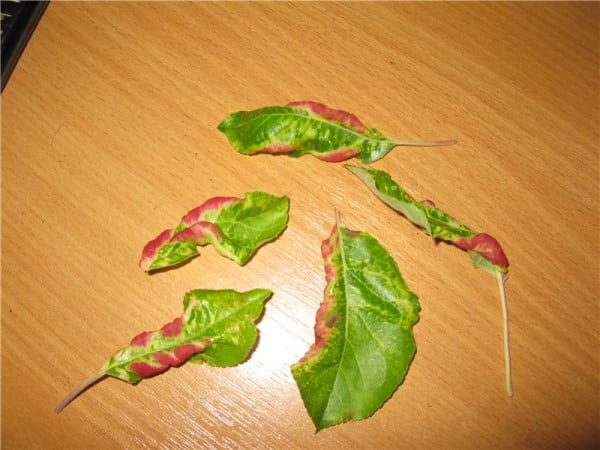
We replenish nutrients
Having determined the reason for twisting and changing the color of the foliage, fertilizing is carried out:
- To replenish phosphorus, bone meal, ammophoska or superphosphate are used. Top dressing is applied in the autumn under the root of the plant.
- Magnesium sulfate and magnesium sulfate will help to increase the magnesium content. The preparations are sprayed on the culture 3 times per season.
You cannot overdo it when filling the deficit of elements. Excess minerals will negatively affect the yield and the health of the foliage.
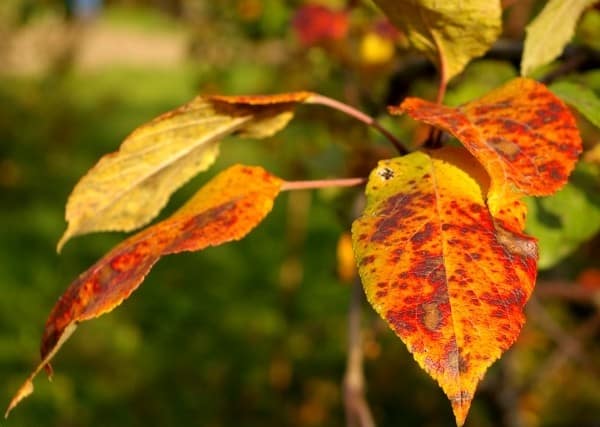
How to treat damaged wood
In August, foliage deformation may be associated with a July drought, which damaged the root system. This problem is easily solved by regular watering. If diseases and insects are not identified, watering is sufficient, and the foliage continues to turn red and curl, then moles may be the cause. They damage the root system of the tree, so you need to get rid of the pest as quickly as possible.
The fight against the disease will be effective if you start it on time. Processing begins in early spring while the buds are dormant. The plant is sprayed with a chemical preparation and a trapping belt is installed to prevent insects from settling on the crop.
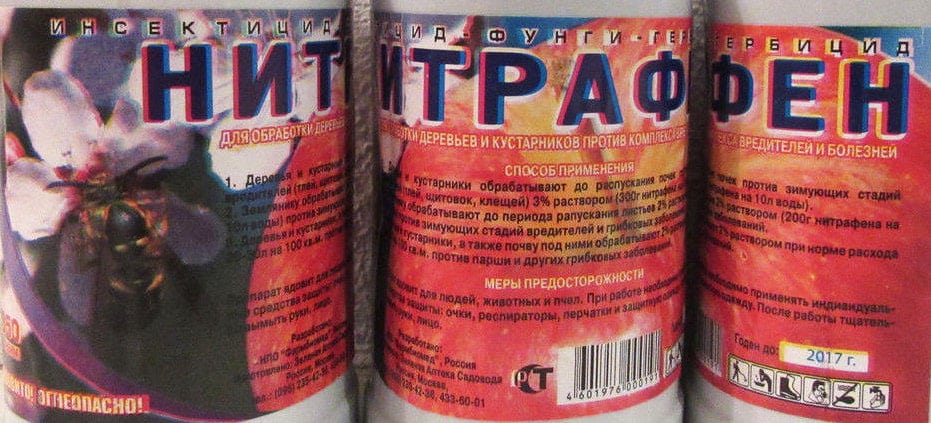
You need to know what to do if the tree is affected by aphids. Treat with the drug:
- "Nitrofen";
- Actellik;
- "Spark";
- "Aktara".
The affected tree is treated at least twice a season. Cannot be processed when fruits are formed and at the time of flowering.
How to treat red spots
Red dots indicate an infectious disease. Stains are treated with fungicides:
- bordeaux mixture;
- "Hom";
- "Kuproksat";
- "Cumulus";
- "Strobe";
- "Speed".
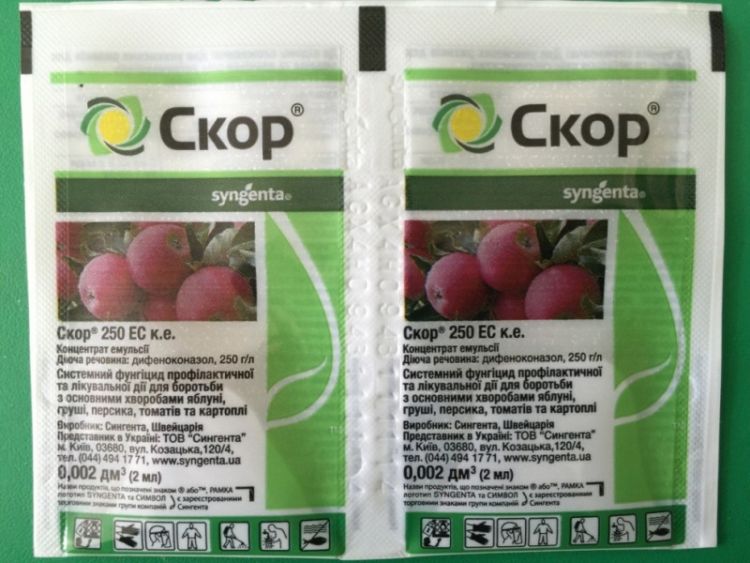
The last time the treatment is carried out 45 days before the ripening of the fruit.
How to treat plaque
At the beginning of the growing season, the plant is treated with a copper preparation. Then it is recommended to use the Horus fungicide. It systemically penetrates and spreads through foliage. It has a healing and protective effect for 2 weeks.
Treating blisters on the leaves
Convex red spots on the leaves indicate a lack of mineral fertilizers. You should feed the plant and get rid of the aphids.
Preventive seasonal treatments
For prevention, the plant is treated with insecticides until the buds swell and during the appearance of the first leaves. Then the process is repeated after flowering. The drugs are alternated so as not to become addictive. In the summer, processing is carried out as needed.In the autumn, they are sprayed with preparations before the trunks are whitened. 45 days before the technical maturity of the fruit, all treatments are stopped.
